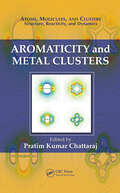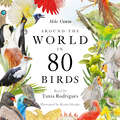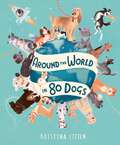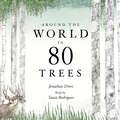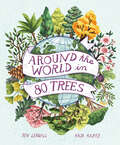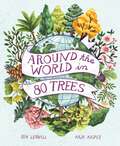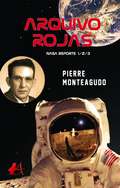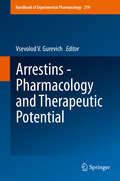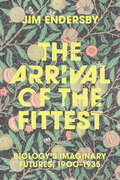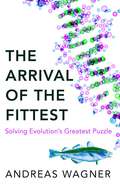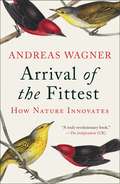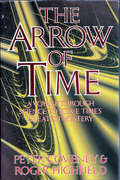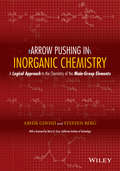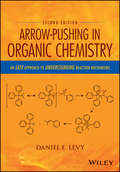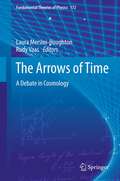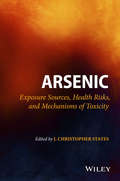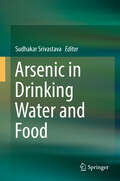- Table View
- List View
Aromaticity and Metal Clusters (Atoms, Molecules, and Clusters)
by Pratim Kumar ChattarajMetal clusters, an intermediate state between molecules and the extended solid, show peculiar bonding and reactivity patterns. Their significance is critical to many areas, including air pollution, interstellar matter, clay minerals, photography, catalysis, quantum dots, and virus crystals. In Aromaticity and Metal Clusters, dozens of international
Around the World in 80 Birds
by Mike UnwinThis beautiful and inspiring book tells the stories of 80 birds around the world: from the Sociable Weaver Bird in Namibia which constructs huge, multi-nest 'apartment blocks' in the desert, to the Bar-headed Goose of China, one of the highest-flying migrants which crosses the Himalayas twice a year.Many birds come steeped in folklore and myth, some are national emblems and a few have inspired scientific revelation or daring conservation projects. Each has a story to tell that sheds a light on our relationship with the natural world and reveals just how deeply birds matter to us.
Around the World in 80 Birds
by Mike UnwinThis beautiful and inspiring book tells the stories of 80 birds around the world: from the Sociable Weaver Bird in Namibia which constructs huge, multi-nest 'apartment blocks' in the desert, to the Bar-headed Goose of China, one of the highest-flying migrants which crosses the Himalayas twice a year.Many birds come steeped in folklore and myth, some are national emblems and a few have inspired scientific revelation or daring conservation projects. Each has a story to tell that sheds a light on our relationship with the natural world and reveals just how deeply birds matter to us.
Around the World in 80 Birds
by Mike UnwinThis beautiful and inspiring book tells the stories of 80 birds around the world: from the Sociable Weaver Bird in Namibia which constructs huge, multi-nest 'apartment blocks' in the desert, to the Bar-headed Goose of China, one of the highest-flying migrants which crosses the Himalayas twice a year.Many birds come steeped in folklore and myth, some are national emblems and a few have inspired scientific revelation or daring conservation projects. Each has a story to tell that sheds a light on our relationship with the natural world and reveals just how deeply birds matter to us.
Around the World in 80 Dogs (Around the World in 80 #5)
by Kristyna LittenWhat is the oldest breed of dog? Can dogs sniff out illnesses? Which breed has six toes?Including a stunning central gatefold that opens out to reveal all 80 dog breeds and where they come from, this book is a visual celebration of the huge variety of dogs found across the world, from those you already know and love to those that may surprise you. As the book takes the reader on a journey around the world, it reveals dogs with the most important jobs, breeds with unusual features, record-breaking dogs and more.Focus spreads will explore subjects such as the canine family, dogs' superpower sense of smell, and how dogs became man's best friend.
Around the World in 80 Plants
by Jonathan DroriAn inspirational and beautifully illustrated book that tells the stories of 80 plants from around the globe.In his follow-up to the bestselling Around the World in 80 Trees, Jonathan Drori takes another trip across the globe, bringing to life the science of plants by revealing how their worlds are intricately entwined with our own history, culture and folklore. From the seemingly familiar tomato and dandelion to the eerie mandrake and Spanish 'moss' of Louisiana, each of these stories is full of surprises. Some have a troubling past, while others have ignited human creativity or enabled whole civilizations to flourish. With a colourful cast of characters all brought to life by illustrator Lucille Clerc, this is a botanical journey of beauty and brilliance.'A beautiful celebration of the plants and flowers that surround us and a quiet call to arms for change' The Herald'This charming and beautifully illustrated book takes readers on a voyage of discovery, exploring the many ingenious and surprising uses for plants in modern science and throughout history' Kew Magazine'With beautiful illustrations from Lucille Clerc, this captivating book traverses the globe via plants: nettles in England, mangoes in India and tulips in the Netherlands' Daily Mail
Around the World in 80 Plants
by Jonathan DroriAn inspirational and beautifully illustrated book that tells the stories of 80 plants from around the globe.In his follow-up to the bestselling Around the World in 80 Trees, Jonathan Drori takes another trip across the globe, bringing to life the science of plants by revealing how their worlds are intricately entwined with our own history, culture and folklore. From the seemingly familiar tomato and dandelion to the eerie mandrake and Spanish 'moss' of Louisiana, each of these stories is full of surprises. Some have a troubling past, while others have ignited human creativity or enabled whole civilizations to flourish. With a colourful cast of characters all brought to life by illustrator Lucille Clerc, this is a botanical journey of beauty and brilliance.'A beautiful celebration of the plants and flowers that surround us and a quiet call to arms for change' The Herald'This charming and beautifully illustrated book takes readers on a voyage of discovery, exploring the many ingenious and surprising uses for plants in modern science and throughout history' Kew Magazine'With beautiful illustrations from Lucille Clerc, this captivating book traverses the globe via plants: nettles in England, mangoes in India and tulips in the Netherlands' Daily Mail
Around the World in 80 Plants
by Jonathan DroriAn inspirational and beautifully illustrated book that tells the stories of 80 plants from around the globe.In his follow-up to the bestselling Around the World in 80 Trees, Jonathan Drori takes another trip across the globe, bringing to life the science of plants by revealing how their worlds are intricately entwined with our own history, culture and folklore. From the seemingly familiar tomato and dandelion to the eerie mandrake and Spanish 'moss' of Louisiana, each of these stories is full of surprises. Some have a troubling past, while others have ignited human creativity or enabled whole civilizations to flourish. With a colourful cast of characters all brought to life by illustrator Lucille Clerc, this is a botanical journey of beauty and brilliance.Praise for Around the World in 80 Trees"Beautiful to behold and to read" - THE SUNDAY TIMES"An arboreal odyssey" - NATURE"One of the most quietly beautiful books of the year" - DAILY MAIL"Jonathan Drori's deep-seated love of nature is contagious in this tree-by-tree journey across countries and continents. A book to take your time over" - WIRED"A brilliant blend of science, history, culture and folklore, this interesting and engaging book explores the relationship between people and trees as it circumnavigates the globe.The quietly passionate writing is informative, interesting and quite delightful. The hardback version, which I've got, is one of the best-produced books I've read in years: the formatting is crisp and inviting, the paper is heavy and of high quality, and almost every page includes colour drawings by artist Lucille Clerc that are simply breathtaking. Together, these features make this book a joy to touch, to hold and to read." - FORBES
Around the World in 80 Trees
by Jonathan Drori Lucille Clerc"An arboreal odyssey" - NATURE"One of the most quietly beautiful books of the year" - DAILY MAILDiscover the secretive world of trees in Jonathan Drori's number one bestseller...Bestselling author and environmentalist Jonathan Drori follows in the footsteps of Phileas Fogg as he tells the stories of 80 magnificent trees from all over the globe.In Around the World in 80 Trees, Jonathan Drori uses plant science to illuminate how trees play a role in every part of human life, from the romantic to the regrettable. From the trees of Britain, to India's sacred banyan tree, they offer us sanctuary and inspiration - not to mention the raw materials for everything from aspirin to maple syrup.Stops on the trip include the lime trees of Berlin's Unter den Linden boulevard, which intoxicate amorous Germans and hungry bees alike, the swankiest streets in nineteenth-century London, which were paved with Australian eucalyptus wood, and the redwood forests of California, where the secret to the trees' soaring heights can be found in the properties of the tiniest drops of water.Each of these strange and true tales - populated by self-mummifying monks, tree-climbing goats and ever-so-slightly radioactive nuts - is illustrated by Lucille Clerc, taking the reader on a journey that is as informative as it is beautiful. The book combines history, science and a wealth of quirky detail - there should be surprises for everyone.Perfect for fans of Peter Wohlleben's The Hidden Life of Trees, this new book will certainly whet the appetite of any tree lover to take an around-the-world trip, or simply visit your local botanic garden. The perfect travel guide for nature enthusiasts."An irresistible mix of science, culture, botany, history and vicarious travel" - SYDNEY MORNING HERALD"Reads like a love song to the natural world, brimming with ancient anecdotes contained within the earth" - CULTURE TRIP
Around the World in 80 Trees (Around the World in 80 #3)
by Ben LerwillWhere can you find Methuselah, the oldest tree in the world? Why is the baobab's trunk so fat? Can trees really warn each other that something is about to eat them? Including a stunning central gatefold that opens out to reveal all 80 trees and how they relate to each other, this book is a visual celebration of the huge variety of trees found across the world, from those you know to those you almost certainly don't. As the book takes the reader on a journey around the world, it reveals trees that give us food and medicine, trees with ancient legends, record-breaking trees and more. Focus spreads will explore subjects such as the life cycle of trees, how they communicate with each other, why trees are vital to the Earth's health, and their importance to us.
Around the World in 80 Trees (Around the World in 80 #3)
by Ben LerwillWhere can you find Methuselah, the oldest tree in the world? Why is the baobab's trunk so fat? Can trees really warn each other that something is about to eat them?Including a stunning central gatefold that opens out to reveal all 80 trees and how they relate to each other, this book is a visual celebration of the huge variety of trees found across the world, from those you know to those you almost certainly don't. As the book takes the reader on a journey around the world, it reveals trees that give us food and medicine, trees with ancient legends, record-breaking trees and more.Focus spreads will explore subjects such as the life cycle of trees, how they communicate with each other, why trees are vital to the Earth's health, and their importance to us.
Around the World in 80 Trees (Around the World in 80 #3)
by Ben LerwillJourney around the globe to gaze up at towering redwoods, marvel at monkey puzzles, and find out which tree has fish swimming around its roots. Discover trees that give us beautiful flowers, delicious treats, and life-saving medicines—and bizarre trees with bloodred sap, fruit that can be used as soap, or even burned as candles. Learn how trees communicate with each other and how they helped us journey to the farthest reaches of our world. Bursting with blossom and the rustling of leaves, explore the tallest, the smallest, and everything in between.Includes a stunning central gatefold that opens out to reveal all 80 trees and how they relate to each other. Focus spreads explore subjects such as the life cycle of trees, how they communicate with each other, why trees are vital to the Earth's health, and their importance to us.A visual celebration of the huge variety of trees found across the globe, from those you know to those you almost certainly don't!
Aroused: The History Of Hormones And How They Control Just About Everything
by Randi Hutter EpsteinA guided tour through the strange science of hormones and the age-old quest to control them. Metabolism, behavior, sleep, mood swings, the immune system, fighting, fleeing, puberty, and sex: these are just a few of the things our bodies control with hormones. Armed with a healthy dose of wit and curiosity, medical journalist Randi Hutter Epstein takes us on a journey through the unusual history of these potent chemicals from a basement filled with jarred nineteenth-century brains to a twenty-first-century hormone clinic in Los Angeles. Brimming with fascinating anecdotes, illuminating new medical research, and humorous details, Aroused introduces the leading scientists who made life-changing discoveries about the hormone imbalances that ail us, as well as the charlatans who used those discoveries to peddle false remedies. Epstein exposes the humanity at the heart of hormone science with her rich cast of characters, including a 1920s doctor promoting vasectomies as a way to boost libido, a female medical student who discovered a pregnancy hormone in the 1940s, and a mother who collected pituitaries, a brain gland, from cadavers as a source of growth hormone to treat her son. Along the way, Epstein explores the functions of hormones such as leptin, oxytocin, estrogen, and testosterone, demystifying the science of endocrinology. A fascinating look at the history and science of some of medicine’s most important discoveries, Aroused reveals the shocking history of hormones through the back rooms, basements, and labs where endocrinology began.
ARQUIVO ROJAS NASA REPORTS 1/2/3
by Pierre MonteagudoEsta é a história de uma criança prodígio chamado Hector Rafael que, com base em sua vontade de ferro, se tornou um astrofísico da NASA e um cientista chave na chegada do homem à Lua.
Arrestins - Pharmacology and Therapeutic Potential (Handbook of Experimental Pharmacology #219)
by Vsevolod V. GurevichThis volume describes our current understanding of the biological role of visual and non-visual arrestins in different cells and tissues, focusing on the mechanisms of arrestin-mediated regulation of GPCRs and non-receptor signaling proteins in health and disease. The book covers wide range of arrestin functions, emphasizing therapeutic potential of targeting arrestin interactions with individual partners.
The Arrival of the Fittest: Biology's Imaginary Futures, 1900–1935
by Jim EndersbyIn the early twentieth century, varied audiences took biology out of the hands of specialists and transformed it into mass culture, transforming our understanding of heredity in the process. In the early twentieth century communities made creative use of the new theories of heredity in circulation at the time, including the now largely forgotten mutation theory of Hugo de Vries. Science fiction writers, socialists, feminists, and utopians are among those who seized on the amazing possibilities of rapid and potentially controllable evolution. De Vries’s highly respected scientific theory only briefly captured the attention of the scientific community, but its many fans appropriated it for their own wildly imaginative ends. Writers from H.G. Wells and Edith Wharton to Charlotte Perkins Gilman, J.B.S. Haldane, and Aldous Huxley created a new kind of imaginary future, which Jim Endersby calls the biotopia. It took the ambiguous possibilities of biology—utopian and dystopian—and reimagined them in ways that still influence the public’s understanding of the life sciences. The Arrival of the Fittest recovers the fascinating, long-forgotten origins of ideas that have informed works of fiction from Brave New World to the X-Men movies, all while reflecting on the lessons—positive and negative—that this period might offer us.
The Arrival of the Fittest: Solving Evolution's Greatest Puzzle
by Andreas WagnerWe all know about natural selection and the so-called survival of the fittest, which governs how evolution preserves useful adaptations in each subsequent generation of a species. Unfortunately, random change alone could not have produced life as we know it - the maths don't add up, according to cutting-edge research by Andreas Wagner in the revolutionary field of computational biology.In the last decade, Wagner has detected the biological networks guiding the creation of innovation. His investigations of the genes of everything from bacteria to humans is rewriting our understanding of how exactly evolution works and providing insights into the origins of creativity, with lessons that can be applied far beyond genomes.In The Arrival of the Fittest, Wagner delivers a breathtaking new look at our origins, from the genes up.
Arrival of the Fittest
by Andreas Wagner"Natural selection can preserve innovations, but it cannot create them. Nature's many innovations--some uncannily perfect--call for natural principles that accelerate life's ability to innovate." Darwin's theory of natural selection explains how useful adaptations are preserved over time. But the biggest mystery about evolution eluded him. As genetics pioneer Hugo de Vries put it, "natural selection may explain the survival of the fittest, but it cannot explain the arrival of the fittest." Can random mutations over a mere 3.8 billion years really be responsible for wings, eyeballs, knees, camouflage, lactose digestion, photosynthesis, and the rest of nature's creative marvels? And if the answer is no, what is the mechanism that explains evolution's speed and efficiency? In Arrival of the Fittest, renowned evolutionary biologist Andreas Wagner draws on over fifteen years of research to present the missing piece in Darwin's theory. Using experimental and computational technologies that were heretofore unimagined, he has found that adaptations are not just driven by chance, but by a set of laws that allow nature to discover new molecules and mechanisms in a fraction of the time that random variation would take. Consider the Arctic cod, a fish that lives and thrives within six degrees of the North Pole, in waters that regularly fall below 0 degrees. At that temperature, the internal fluids of most organisms turn into ice crystals. And yet, the arctic cod survives by producing proteins that lower the freezing temperature of its body fluids, much like antifreeze does for a car's engine coolant. The invention of those proteins is an archetypal example of nature's enormous powers of creativity. Meticulously researched, carefully argued, evocatively written, and full of fascinating examples from the animal kingdom, Arrival of the Fittest offers up the final puzzle piece in the mystery of life's rich diversity.
The Arrow Of Time
by Roger Highfield Dr Peter CoveneyIn our century, the subject of time has become an area of serious inquiry for science. Theories that contain time as a simple quantity form the basis of our understanding of many scientific disciplines, yet the debate rages on: why does there seem to be a direction to time, an arrow of time pointing from past to future?In this authoritative and accessible Sunday Times bestseller, physical chemist Dr Peter Coveney and award-winning science journalist Dr Roger Highfield demonstrate that the common sense view of time agrees with the most advanced scientific theory. Time does in fact move like an arrow, shooting forward into what is genuinely unknown, leaving the past immutably behind. The authors make their case by exploring three centuries of science, offering bold reinterpretations of Newton’s mechanics, Einstein’s special and general theories of relativity, quantum mechanics, and advancing the insights of chaos theory. In their voyage through science the authors link apparently irreconcilable subjects, from Einstein’s obsession with causality to chaos theory, from Marvell’s winged chariot to that Monday morning feeling.Finally, drawing together the various interpretations of time, they describe a novel way to give it a sense of direction. And they call for a new fundamental theory to take account of the Arrow of Time.Foreword by Ilya Prigogine, Nobel laureate.
Arrow Pushing in Inorganic Chemistry
by Steffen Berg Abhik GhoshInvolved as it is with 95% of the periodic table, inorganic chemistry is one of the foundational subjects of scientific study. Inorganic catalysts are used in crucial industrial processes and the field, to a significant extent, also forms the basis of nanotechnology. Unfortunately, the subject is not a popular one for undergraduates. This book aims to take a step to change this state of affairs by presenting a mechanistic, logical introduction to the subject. Organic teaching places heavy emphasis on reaction mechanisms - "arrow-pushing" - and the authors of this book have found that a mechanistic approach works just as well for elementary inorganic chemistry. As opposed to listening to formal lectures or learning the material by heart, by teaching students to recognize common inorganic species as electrophiles and nucleophiles, coupled with organic-style arrow-pushing, this book serves as a gentle and stimulating introduction to inorganic chemistry, providing students with the knowledge and opportunity to solve inorganic reaction mechanisms. * The first book to apply the arrow-pushing method to inorganic chemistry teaching * With the reaction mechanisms approach ("arrow-pushing"), students will no longer have to rely on memorization as a device for learning this subject, but will instead have a logical foundation for this area of study * Teaches students to recognize common inorganic species as electrophiles and nucleophiles, coupled with organic-style arrow-pushing * Provides a degree of integration with what students learn in organic chemistry, facilitating learning of this subject * Serves as an invaluable companion to any introductory inorganic chemistry textbook
Arrow-Pushing in Organic Chemistry: An Easy Approach to Understanding Reaction Mechanisms
by Daniel E. LevyOrganic chemistry is required coursework for degrees in life, food, and medical sciences. To help the students discouraged by the belief that this topic cannot be mastered without significant memorization, Arrow Pushing in Organic Chemistry serves as a handy supplement for understanding the subject.• Includes new chapters, an expanded index, and additional problem sets complete with detailed solutions• Focuses on understanding the mechanics and logic of organic reaction mechanisms• Introduces ionic and non-ionic reactive species and reaction mechanisms• Teaches strategies to predict reactive species, sites of reactions, and reaction products• Provides a solid foundation upon which organic chemistry students can advance with confidence
The Arrows of Time
by Laura Mersini-Houghton Rudy VaasThe concept of time has fascinated humanity throughout recorded history, and it remains one of the biggest mysteries in science and philosophy. Time is clearly one of the fundamental building blocks of the universe and thus a deeper understanding of nature at a fundamental level also demands a comprehension of time. Furthermore, the origins of the universe are closely intertwined with the puzzle of time: Did time emerge at the Big Bang? Why does the arrow of time 'conspire' with the order of the initial state of the universe? This book addresses many of the most important questions about time: What is time, and is it fundamental or emergent? Why is there such an arrow of time, closely related to the initial state of the universe, and why do the cosmic, thermodynamic and other arrows agree? These issues are discussed here by leading experts, and each offers a new perspective on the debate. Their contributions delve into the most difficult research topic in physics, also describing the latest cutting edge research on the subject. The book also offers readers a comparison between the different outlooks of philosophy, physics and cosmology on the puzzle of time. This volume is intended to be useful for research purposes, but most chapters are also accessible to a more general audience of scientifically educated readers looking for deeper insights.
Arsenic
by J. Christopher StatesThis book illustrates the chemistry, toxicology, and health effects of arsenic using novel modeling techniques, case studies, experimental data, and future perspectives.* Covers exposure sources, health risks, and mechanisms of one of the most toxic minerals in the world* Helps readers understand potential health effects of arsenic, using population studies, mammalian and invertebrate models, and pharmacokinetic and toxicokinetic models* Discusses outcomes, epidemiology, real-life examples, and modes of action for arsenic-induced diseases, like lung cancer, diabetes, cardiovascular and pulmonary diseases, and immunotoxicity* Acts as a reference for toxicologists, environmental chemists, and risk assessors and includes up-to-date, novel modeling techniques for scientists* Includes future perspectives on special topics, like extrapolation from experimental models to human exposures, biomarkers for phenotypic anchoring, and pathology of chronic exposure
Arsenic in Drinking Water
by National Research CouncilThe U.S. Environmental Protection Agency (EPA) has been considering a more stringent regulation of arsenic in water. A significant reduction in the maximum contaminant level (MCL) could increase compliance costs for water utilities. This book discusses the adequacy of the current EPA MCL for protecting human health in the context of stated EPA policy and provides an unbiased scientific basis for deriving the arsenic standard for drinking water and surface water.Arsenic in Drinking Water evaluates epidemiological data on the carcinogenic and noncarcinogenic health effects of arsenic exposure of Taiwanese populations and compares those effects with the effects of arsenic exposure demonstrated in other countries—including the United States.The book also reviews data on toxicokinetics, metabolism, and mechanism and mode of action of arsenic to ascertain how these data could assist in assessing human health risks from arsenic exposures. This volume recommends specific changes to improve the toxicity analyses and risk characterization. The implications of the changes for EPA’s current MCL for arsenic are also described.
Arsenic in Drinking Water and Food
by Sudhakar SrivastavaArsenic contamination poses a major environmental problem, especially in Southeast Asian countries like Bangladesh and India. Threatening the health of millions of people due to arsenic’s toxicity and carcinogenicity, the major routes of arsenic exposure for humans are either through drinking water or crops. Rice is the crop most affected by arsenic owing to its cultivation in major arsenic contaminated areas, biogeochemical factors in the soil during rice growth, and specific features of rice that enable it take up more arsenic than other crop plants. This book addresses the problem of arsenic by pursuing a holistic approach. It presents the status quo in different parts of the world (North and South America, Europe, Asia, etc.) and provides essential information on food-related arsenic exposure risks for humans, and possible preventive and curative measures for tackling arsenic poisoning. It covers the arsenic contamination status of rice, rice-based products, other vegetables, fishes, mushrooms, and other foods, with a special focus on rice-arsenic interactions. The mechanisms of arsenic uptake, translocation and distribution in plants and grains are also explained. In closing, the book reviews a variety of prospective agronomic and biotechnological solutions to the problem of arsenic accumulation in rice grains. The book is intended for a broad audience including researchers, scientists, and readers with diverse backgrounds including agriculture, environmental science, food science, environmental management, and human health. It can also be used as an important reference guide for undergraduate and graduate students, university faculties, and environmentalists.
